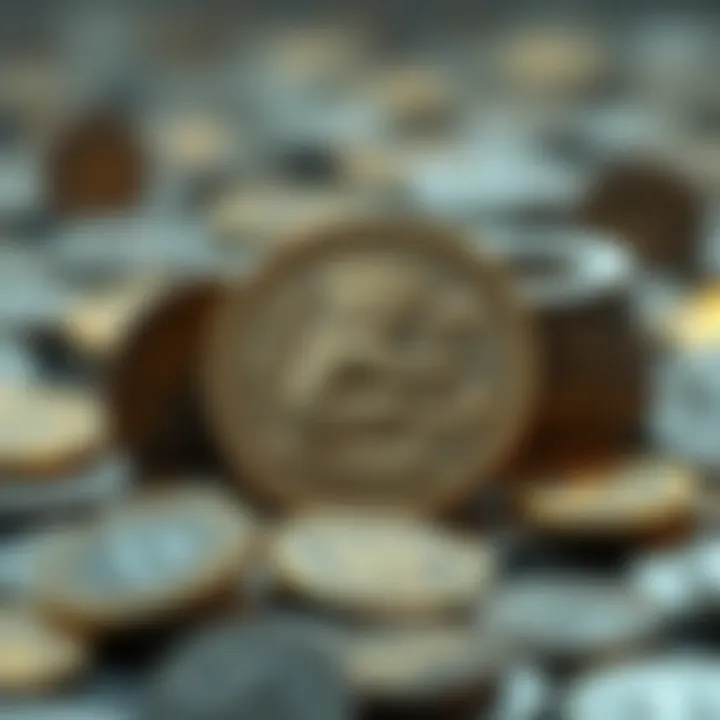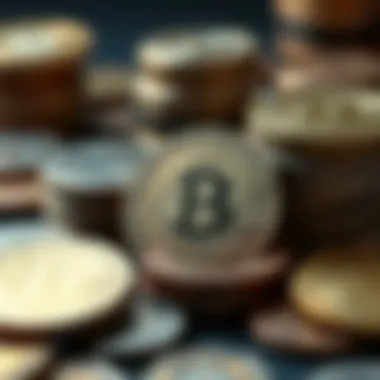A Deep Dive into the Evolution of Coin History


Intro
Coins have long been the building blocks of trade and economic systems across societies, shaping interactions in countless ways. Their evolution has reflected changes in culture, politics, and technological advancements—and understanding this trajectory enables a deeper grasp of how they continue to influence modern economies. From the primitive use of barter systems to the birth of coins, and evolving all the way through to today's digital currencies, the story of coinage is as much about human development as it is about simple forms of exchange.
In this article, we’ll traverse the rich landscape of coin history—from ancient empires that minted coins for trade to the innovative rise of cryptocurrencies that challenge traditional financial paradigms. The intricate details we'll uncover will highlight the transformative power of coins not just as instruments of commerce, but also as markers of culture and identity.
"Money has no motherland; financiers are without patriotism; and merchants have no country." – Napoleon Bonaparte
Let’s explore the pressing concepts in cryptocurrency that have emerged as significant players in our current economic narrative.
Intro to Coinage
Coins represent far more than mere metal discs bearing inscriptions. They embody the essence of economic and cultural progress, marking a departure from barter systems to a more structured means of trade. Understanding the topic of coinage is crucial as it sheds light on the evolution of economies and social structures across the globe. This section will explore how coins are not just instruments of exchange but also reflections of society’s values and technological advancements.
Definition of Coinage
Coinage refers to the process of producing coins for use as currency. A coin typically consists of a metal disc that is stamped with distinctive designs, symbols, and sometimes even engravings that denote its value. Simply put, coins are a standardized form of money which are minted by governmental authority. Their primary function lies in facilitating trade by providing a tangible medium that holds value. Coins vary not only in size and shape but also in material, reflecting the abundance or scarcity of metals at different points in history. Coins can be made from gold, silver, copper, or more modern materials like nickel and zinc. This definition encapsulates the foundation of monetary systems that have shaped economies for centuries.
The Purpose of Coins
The purposes of coins extend far beyond simply serving as a medium for transactions. They have been central to the development of trade and commerce, acting as a reliable standard for measuring value. Some key purposes of coins include:
- Facilitating Trade: By providing a universally accepted form of currency, coins have allowed people to trade goods and services more efficiently than bartering with items of varying value.
- Storing Value: Coins serve as a safe, durable way to store wealth. Unlike perishable goods, coins can maintain value over long periods if preserved properly.
- Encouraging Economic Growth: With a reliable currency, economies can flourish, leading to increased trade and better living standards. The consistency provided by coinage allows for long-term financial planning for individuals and businesses alike.
- Cultural Expression: Coins often bear the likeness of influential figures, symbols of power, or emblems representative of a nation’s heritage. This aspect turns coins into artifacts that tell the story of a culture’s values and historical legacy.
In summary, understanding coinage and its purposes lays the groundwork for appreciating the intricate tapestry of economic history. By examining the multifunctional role coins play in society, we glean insights into how civilizations have shaped their economic systems and, by extension, their identities over time.
"Coins are not only a means of trade but also mirrors reflecting the socio-economic environment of their times."
For further insights on the history and impact of coinage, feel free to explore resources such as Wikipedia on Currency and Britannica on Coinage.
With this foundational knowledge, we can now explore the origins of coinage, paving the way to understand its evolution through various cultures.
Origins of Coinage
Exploring the Origins of Coinage is crucial to understanding the very foundation of monetary systems that we see today. Coins are not just small pieces of metal, but symbols of trust, transactions, and trade, bridging gaps between buyers and sellers in a complex economy. By tracing their lineage, we uncover how early societies solved problems related to trade and valuation, evolving from bartering systems to tangible currency. This evolution marks a pivotal change in human interaction and commerce, laying the groundwork for modern economies and marketplaces.
Early Forms of Currency
Before coins made their grand entrance, various civilizations relied on early forms of currency which were often cumbersome but served their purposes well. For instance, Long before coins, the Sumerians in Mesopotamia utilized barley as a standard for trading. Barley was not only easy to transport but also had intrinsic value as a food source, lending itself well to both agricultural and trade practices.
Similarly, the Egyptians traded with a system of weights and measures, where goods were assessed by their volume or mass. Shells, as well, were commonly used across many cultures, including the famous cowrie shells in Africa and Asia, representing a more portable and easily assessed alternative for trade.
- Barley: A staple crop that functioned as a medium of exchange in Mesopotamia.
- Shells: Natural items that became widely recognized as currency across various regions.
- Wampum: Crafted from shells by Native Americans, used for trade and forgeries of an agreements.
These early monetary systems demonstrated the need for a medium of exchange solid enough to facilitate trade yet flexible enough to accommodate various goods. The move from these informal currencies to a standardized coinage was a logical step driven by the necessity for efficiency in commerce.
The First Coins
The advent of coins represents a monumental leap in the evolution of currency. Around the 7th century BCE, the Lydians in what is now Turkey minted the first official coins made of electrum, a naturally occurring alloy of gold and silver. These coins was not just simple metal tokens; they bore marks indicating weight and legitimacy, making them universally accepted across traders.
- Lydian Coins: The first standardized currency from Lydian empire, providing the model for future minting.
- Athenian Tetradrachm: A silver coin that became a benchmark for trade routes across the Mediterranean.
The utility of these coins lay in their intrinsic value and ease of use; they could be carried, weighed, and exchanged seamlessly. The use of coins allowed for a greater complexity in economies, enabling merchants to conduct trade on larger scales and across greater distances, drawing disparate regions into a web of commerce.
The introduction of coins revolutionized trade by providing a circumscribed unit of value, simplifying transactions and fostering economic growth across empires.
Coinage not only facilitated trade but also became a powerful tool for governments. By controlling the minting process, rulers could assert authority and influence over their territory. Thus, early coins became symbols of power and civilization, intertwined with the social and political dynamics of their time.
In summary, the origins of coinage reflect human ingenuity in solving trade challenges. From barley to coins, the journey underscores humanity's quest for efficiency and a common ground in the realm of exchange. As we explore further, we will see how these early coins inspired entire economic systems and cultural trends that echo even today.
Evolution of Coins
The story of coins is not just about metal disks stamped with figures; it’s about human ingenuity and adaptation over centuries. The evolution of coins represents pivotal shifts in economic practices, societal structures, and even political ideologies. By examining how coins advanced through time, we can better understand their role in shaping trade relations and influencing cultures around the globe. This section will delve into two key components of the coin evolution process: metalworking advancements and standardization of coinage.
Metalworking Advancements
In the early days, coins were crafted from materials that were easily available, such as bronze, silver, and gold. However, the innovation in metalworking techniques was a game-changer. As civilizations encountered the need for more durable and standardized currency, advancements in metallurgy played an essential role in this evolution.
For instance, the development of smelting processes allowed for higher purity levels in precious metals. This led to coins becoming more reliable as a means of trade. Take the Lydoian coins from around 600 BCE, for example. They were the first to utilize electrum—a natural alloy of gold and silver—resulting in a coin that had a consistent weight and quality, thus fostering trust among traders.
Moreover, the method of minting coins gradually improved. The use of dies for stamping coins became widespread, ensuring that every piece carried uniform designs and weights. This consistency in appearance and size not only simplified transactions but also served to enhance the authority of states that issued the coins. In places like ancient Rome, the image on the coin often depicted the emperor, thus reinforcing his power and legitimacy in society.
Standardization of Coinage
Moving forward, it was the standardization of coinage that truly transformed economics. Before this shift, each region might have had its own weights and measures, making trade a cumbersome process. It was necessary to reach a consensus on what constituted a fair exchange.


Standardization efforts began mainly in the Greek and Roman empires, where a common currency system emerged. These efforts allowed for easier trade across vast regions. The introduction of standardized coins—such as the aureus and the denarius—meant merchants no longer had to question the value of currency in different areas. Here are some benefits of this coin standardization:
- Facilitated trade: Merchants could engage in commerce without needing to weigh and evaluate coins.
- Economic growth: A unified coinage often led to enhanced economic stability and growth, as it encouraged trade over larger distances.
- Political unity: The issuance of standardized coins often coincided with the expansion and consolidation of empires, symbolizing control and unity.
The significance of these advancements in metalworking and standardization cannot be understated. They wove a complex web of economic interdependency that laid the groundwork for modern banking systems and international trade.
"Coins are not merely currency; they are the echoes of history, each coin a small monument to the people and ideas of its time."
By understanding these elements in the evolution of coins, readers gain insight into the foundational structures that have shaped our current economic systems. This evolution is not just a tale of metal; it is a narrative about how societies adapt to changing needs and circumstances in the world of commerce.
Coins Across Cultures
Coins provide a tangible representation of cultural shifts and economic advancements across history. They are not mere metal discs; they are a reflection of the society that produces them, capturing the essence of varying traditions, values, and historical narratives. Analyzing coins across cultures is crucial to understanding how different civilizations have contributed to the concept of currency and trade. This exploration showcases the diverse ways societies have expressed their identity through coinage and the interconnections established via commerce throughout different regions.
Greek Coinage
Greek coinage marked a pivotal moment in the evolution of money. Not only did ancient Greeks standardize coins, but they also introduced designs that reflected their values and triumphs. The depiction of gods, heroes, and symbols on coins had cultural significance, serving as propaganda tools as much as currency. These coins facilitated trade between city-states, solidifying economic relations fueled by not just commerce but also shared cultural narratives. For example, the famous silver drachm, adorned with the owl, symbolized wisdom and often facilitated trade in Athens, enhancing its economy.
"Coins are an artifact of the past but a beacon for the future, guiding trade and cultural exchange in a rich tapestry of interwoven stories."
Through these coins, the ancient Greeks instilled a sense of civic pride and identity. The local craftsmanship was showcased through striking designs and inscriptions, making each piece a small work of art, indicative of the societal values upheld by its creators.
Roman Contributions
The Romans expanded upon the concept of coinage significantly, turning it into an instrument of imperial control and unity across their vast empire. Roman coins were not only currencies but also vessels of political messages. They enabled efficient trade across diverse geographical areas and cultures, promoting economic integration. For instance, the introduction of the denarius standardized exchange rates across different regions, which was essential as their territory spanned Europe, North Africa, and parts of Asia.
The audacity of Roman emperors to portray themselves on coins was a bold move, projecting power and influencing public opinion. As the saying goes, "the pen is mightier than the sword," but in this case, the coin proved equally potent, helping disseminate propaganda far and wide, reinforcing the
The Role of Coins in Trade
Throughout history, coins have played a crucial role in shaping the modalities of trade across civilizations. Their introduction marked a significant shift in economic interactions, moving from cumbersome barter systems to a more sophisticated means of exchange. Beyond simply acting as a medium of exchange, coins enabled a vast array of trade possibilities, influencing not only local economies but also international commerce.
Coins and Commerce
Coins have been pivotal in commerce since their inception. Unlike goods, which can be unwieldy and variable in value, coins provided a standardized medium that everyone could agree on. This standardization is important because it enabled individuals and businesses to assess value quickly and efficiently, fostering smoother transactions.
One of the earliest examples comes from ancient Lydia, where the first coins were minted around 600 BCE from electrum, a naturally occurring alloy of gold and silver. The ability to carry a small piece of metal that represented a specific value transformed daily trading activities. Merchants who once carried bags of goods could now conduct their business with a few coins in their pockets, simplifying and speeding up commerce.
The benefits coins brought to commerce also extend beyond convenience. They facilitated the growth of markets and trade routes, laying down the foundation for economic systems we recognize today. Merchants could travel further with confidence, knowing that they could use coins accepted in various regions to conduct their business. Modern economic systems, from local farmer markets to sprawling international trade networks, owe much to this early innovation.
Moreover, coins possess intrinsic characteristics that are beneficial in trade: their durability, portability, and divisibility. Each characteristic earns its keep. Durability ensures that coins can withstand the abrasive nature of commerce. Portability means that vast amounts of wealth can be represented in small physical volumes. Divisibility allows for transactions of varying sizes without forcing businesses to struggle with fractional goods.
"Coins transformed local markets into bustling centers of commerce, enhancing both trade efficiency and economic growth."
Regional Trade Networks
As coins became widespread, they not only served individual merchants but also promoted the formation of regional trade networks. The versatility of coins allowed traders from different regions to interact and exchange goods more easily. During the Hellenistic period, exchange networks expanded significantly, connecting far-flung territories.
These networks were crucial for cultural exchange and economic interdependence. For example, the Silk Road, one of the world's earliest and most significant trade routes, relied heavily on the use of coins for transactions involving silk, spices, and other goods. As traders moved along the route, they used coins minted in their home cities or local versions, creating a tapestry of economic interaction that transcended borders.
Additionally, different regions developed their own monetary systems based on locally minted coins, which could be used to identify the origin of the currency and, by extension, the goods being traded. This fostered trust among traders and allowed people to engage with unknown merchants with relative security.
In more recent centuries, the influence of coins on trade networks has been equally powerful. The establishment of the gold standard brought about a new level of confidence in trade, particularly during the 19th century. Countries began to stabilize their currencies, making it easier for merchants to engage in international trade.
Ultimately, coins have profoundly impacted trade by allowing for easier transaction processes, building trust among commerce participants, and encouraging economic growth through regional networks. As we look toward the future, it remains to be seen how modern innovations such as digital currencies may reshape this age-old practice.
Coins and Power
The intersection of coins and power serves as a reflection of society's values and hierarchies throughout history. Understanding this relationship unveils layers of economic and political dynamics that have shaped nations. Coins have not merely functioned as currency; they have acted as instruments of authority, tools of propaganda, and symbols of culture and identity. This section aims to explore how coinage has influenced power structures from ancient monarchies to contemporary state economies, underscoring its significance in both historical and modern contexts.
Authority and Minting
When examining the authority embodied in coins, it’s essential to consider the role of minting. Minting is the process through which monetary tokens are produced, and it serves as a direct manifestation of a state's power. The authority to mint coins has traditionally rested in the hands of rulers, who leverage this privilege to reinforce their status and legitimacy.
For instance, in ancient Rome, emperors often portrayed their images on coins, thereby using these pieces to communicate their power to the public. Coins bearing an emperor's likeness were more than mere currency; they were political instruments that spread the ruler's image across the empire, reinforcing loyalty and allegiance. Furthermore, unique features such as inscriptions or symbols pertinent to the regime could invoke a sense of unity among citizens.
"Coins do not merely reflect the economy; they reflect the authority behind them."
Minting operations were also closely guarded. Control over mint facilities meant power over the flow of wealth. In various empires, such as the Byzantine or Ottoman, the minting process was a closely monitored activity, often requiring specialized artisans to ensure quality and consistency. The reliability of a currency reflects a state’s fiscal health and political stability, suggesting that authority goes hand in hand with the assurance of value in coinage.
Propaganda and Symbolism
Coinage has long served as a canvas for political propaganda and cultural symbolism. The images and inscriptions on coins often reveal significant aspects of a civilization’s beliefs, triumphs, and ideologies. The mere act of creating a coin can carry deep political meanings.
For example, during the height of the Soviet Union, coins featured imagery of the hammer and sickle. These symbols resonated deeply with communist ideology, representing a worker's solidarity. Such illustrations facilitated not only the economic system but also the ideological framework promoted by the state.


Moreover, coins can commemorate pivotal events or figures in history. In 1969, after putting a man on the moon, the United States minted the Apollo 11 coin. This not only celebrated a scientific achievement but also articulated a message about American ingenuity and resilience.
In modern times, countries have adopted coins that reflect social issues or figures promoting national identity. For instance, Canada has coins that feature indigenous symbols, acknowledging the heritage and contribution of Native cultures within the country's narrative. It’s a powerful use of currency that intertwines economic utility with cultural recognition.
Modern Coins
In the context of our exploration into coin history, modern coins symbolize a watershed moment in the evolution of currency. While ancient coins served as tangible assets representing value and wealth, contemporary coins carry significant implications not only for economics but also for cultural identity and government authority. Today's coins have transcended their original roles, becoming essential to the fabric of modern financial systems.
From a practical standpoint, modern coins often maintain a dual function: as circulating currency and as commemorative items. Coins minted for regular usage are produced in various metals, including copper, nickel, and zinc, serving everyday transactions. Conversely, special editions celebrate milestones or cultures and tend to attract collectors and investors alike.
This bipartite nature positions modern coins as instruments for economic education. For instance, they help teach monetary value and financial literacy to younger generations, fostering an understanding of economic principles that underpin society. On the flip side, coins can also reflect statehood and national pride. By portraying national symbols or key historical figures, coins connect individuals to their heritage and serve as a reminder of a nation's identity.
Additionally, the shift towards paper money and digital currencies has influenced the use of coins. Conventional coins face challenges in a rapidly evolving economy. However, they remain advantageous in certain contexts where cash is essential, such as in small transactions or in regions with limited banking facilities.
"Coins might be small, but they hold the power of history and identity within their metallic cores."
The Shift to Paper Money
The transition to paper currency marked a turning point in economic practice, profoundly affecting how trade and commerce evolved. While modern coins have their place, paper money offers several benefits that often make it the preferred choice for larger transactions.
Why this shift happened? Primarily, it was due to the sheer convenience that paper money affords when compared to metal coins. Handling a large number of coins can be cumbersome and inconvenient. Paper notes also have a higher value-to-weight ratio, making them easier to carry around.
The advantages can be summarized in a few key points:
- Reduced weight: It’s far less burdensome to carry a few notes than a pocketful of coins.
- Increased denominations: Paper bills can represent larger amounts of value, facilitating larger purchases and investments.
- Practical application in trade: Trade dynamics have shifted heavily towards digital payments and credit systems, where paper currency is more manageable than coins.
However, the shift also brought challenges. With the growth of electronic currency, the risk of counterfeiting has soared. Governments wrestle with maintaining the integrity of their paper money systems, sparking innovations in security features. While coins may have their limitations, the trust they command is sometimes unshakeable.
Coin Collecting and Numismatics
Coin collecting, or numismatics, has evolved from a hobby to a sophisticated investing avenue. The appreciation of coins goes beyond mere monetary value. Collectors dive into the narratives and histories behind each coin, uncovering tales that breathe life into metal medallions.
Modern coin collectors are increasingly diverse, drawn from all walks of life. Their motivations vary:
- Some collectors seek aesthetic enjoyment, appreciating the artistry involved in coin design.
- Others look at investment potential, purchasing rare or historically significant coins that may appreciate over time.
The world of numismatics is rich, with enthusiasts often discovering a penchant for specific categories, such as:
- Ancient coins from various civilizations.
- Commemorative coins released by governments celebrating important events.
- Modern bullion coins, which are valued based on their metal content.
Collectors often engage with each other through online platforms and forums, such as Reddit or on specialized websites like Numismatic Guaranty Corporation (NGC). The digital age has allowed collectors to share insights, market trends, and valuation tips more easily than ever before.
In summary, modern coins encapsulate a unique intersection of history, culture, and economy. They invite us to look beyond mere transactions and recognize the stories engraved in metal, while simultaneously navigating the transitions in our financial landscape.
Digital Coins and Cryptocurrency
The advent of digital coins and cryptocurrency marks a pivotal shift in the evolution of currency as we know it. As we step further into the 21st century, the relevance of these digital assets cannot be overstated, particularly when considering how they interact with traditional economic systems, influence consumer behavior, and redefine the very concept of money itself. Digital coins are not just a technological innovation; they signify a new paradigm of financial inclusion that can bridge gaps left by conventional banking systems. As digital currencies proliferate, understanding their complexity, benefits, and potential pitfalls becomes essential for all stakeholders, from investors to policymakers.
Emergence of Digital Currency
Digital currency made its first splash into the mainstream with Bitcoin's introduction in 2009. Originally conceived as a decentralized alternative to fiat currency, Bitcoin was revolutionary. By utilizing blockchain technology, it secured transactions without intermediaries, allowing for peer-to-peer exchanges that left traditional banks in the dust. The novelty of this digital token caught the attention of tech enthusiasts and investors alike, leading to an explosion in interest surrounding not just Bitcoin, but also a myriad of other cryptocurrencies.
In the years following its emergence, many alternative cryptocurrencies have emerged, each trying to solve various issues that plague existing financial systems. Ethereum introduced functionality beyond simple transactions, enabling the deployment of smart contracts. Litecoin aimed to offer faster transaction times. This diversity illustrates how digital currencies have evolved to meet the specific needs of users and industries, making their mark not just in finance but in real-world applications such as supply chain management and identity verification.
Blockchain Technology's Impact
Blockchain technology serves as the backbone of digital currencies, ensuring transparency, security, and efficiency in transactions. At its core, blockchain is a distributed ledger that records all transactions across a network, making it nearly impossible to alter previous entries. This decentralization is a game-changer in a world often suffered by fraud and corruption. The impact of blockchain is felt across various sectors — notably finance, healthcare, and logistics.
The smart use of blockchain can foster a level of trust that has often been absent in transactions. Traditional systems rely heavily on trust in institutions; blockchain decentralizes that trust among all actors in the network.
Moreover, blockchain technology has paved the way for various innovative use cases, such as the creation of non-fungible tokens (NFTs), which allow for true ownership of digital assets. This technology's transparency and security features are valued not only for cryptocurrencies but also for ensuring the integrity of data in other domains.
In summary, the rise of digital coins and their underlying blockchain technology has prompted a reconsideration of financial systems worldwide.
- Benefits include:
- Considerations to keep in mind:
- Increased transaction speeds
- Lower fees compared to traditional banking
- Greater accessibility for unbanked populations
- Regulatory challenges
- Market volatility
- Security risks in managing digital wallets
The ongoing evolution of digital currencies and the renewable possibilities they entail suggest that their impact on the economies of tomorrow will be profound. Investors, educators, developers, analysts, and marketers must keep their ear to the ground to stay informed in this rapidly changing landscape.
For further information on blockchain technology, consider visiting resources such as Wikipedia, or Britannica.
As we explore the future of coins, it's crucial to monitor the continuing developments in the digital currency space and how they interact with the global economic fabric.


Impact of Coins on Modern Economy
Coins, despite the surge of paper and digital currency, still hold substantial weight in the modern economy. Their influence is entwined with key elements that dictate the flow of commerce and the overall health of economic systems. From facilitating everyday transactions to representing national pride through minting efforts, coins play a multifaceted role in our financial landscape. Understanding their impact reveals much about not just economics, but also cultural identity and historical evolution.
Inflation and Coinage
Inflation affects the value of money—coins included—often causing a loss in purchasing power over time. When a country experiences inflation, the value of its coins diminishes, leading to higher prices for goods and services. This phenomenon can be particularly striking in nations that print large amounts of currency without backing it with tangible assets.
- Historical Context: Throughout history, inflation has shaped the way coins are produced. For instance, during the Roman Empire, the silver content in coins was gradually reduced to address economic pressures, which led to rampant inflation. This not only impacted trust in currency but also highlighted a governmental struggle to maintain economic stability.
- Modern Examples: Present-day nations, like Zimbabwe, have faced hyperinflation where the value of the currency plummeted so much that coins essentially became worthless. Inflation influences not only the consumer but also businesses; pricing strategies often adapt in response to changes in coin value, which impacts investment decisions.
"Inflation is like a slow leak in a tire—if not addressed, it will lead to a flat out economy."
Digital advancements, too, come into play. Cryptocurrencies are often designed to hedge against inflation through limited supply models. These new forms of coins spark debates around traditional banking systems committing central banks to maintain coin values amidst fluctuating currencies.
Global Trade Implications
Coins also serve as a vessel for international trade, allowing for cross-border transactions in a simplified manner. The implications of coins on global trade cannot be overstated, as they facilitate the transfer of value in a way that anticipates the needs of varying markets.
- Standardization Across Borders: When countries mint coins with recognizable values, they create a form of consistency and standardization that traders can rely on. For instance, the Euro has become a mainstay in many European economies, allowing for seamless trade within the Eurozone. This kind of currency unification reduces transaction costs and timeframes, thereby streamlining commerce.
- Currency Exchange Dynamics: The role of coins in international markets involves not just physical transactions but also the dynamics of currency exchange. Fluctuating coin values can significantly impact trade balances, affecting everything from import prices to export revenues. Understanding these fluctuations allows traders and economists to make more informed decisions in predicting market trends.
Ultimately, coins, though seemingly modern relics, wield considerable influence in shaping trade policies, economic relationships, and overall financial systems in our interconnected world.
For those interested in exploring more about currency economics, resources like Wikipedia and Britannica provide in-depth insights into the history and evolution of coinage.
Future of Coins
The domain of currency is undergoing a seismic shift, driven by technological advancements and socio-economic changes. When considering the future of coins, we enter a sphere where tradition meets innovation. This topic holds significant importance in the narrative of coin history, as it encapsulates where we've been and where we might be headed, offering valuable insights for investors, educators, developers, analysts, and marketers alike.
As coins began their journey in the ancient world, they facilitated trade and governed economies. Fast forward to today, and we are witnessing the rise of digital currencies like Bitcoin and Ethereum, leading many to ponder the fate of traditional coinage. Will physical coins become mere artifacts of history or will they find a new role in an increasingly digital society? The future of coins is not just about survival; it’s about evolution.
Potential Trends in Currency
Several key trends are shaping the landscape of coinage:
- Increased Digital Acceptance: As society becomes more tech-savvy, more transactions are likely to occur online. Digital wallets and mobile payments have already set the stage for a decline in cash usage.
- Central Bank Digital Currencies (CBDCs): Nations are exploring their own forms of digital currencies, creating a standardized alternative to decentralized cryptocurrencies. This may lead to a regulatory framework around digital assets, ensuring security and trust.
- Sustainability Consciousness: Traditional metal coins face criticism regarding their environmental impact. Future coins might be developed from sustainable materials, addressing both user concerns and ecological responsibilities.
- Integration of Biometric Technology: As security becomes a paramount concern, biometric identification may integrate with digital currencies for safer transactions, thereby enhancing user confidence.
- Rise of Cryptographic Privacy Coins: Privacy-centric coins could garner interest from those wary of surveillance, further complicating the currency landscape.
The unfolding trends suggest a vibrant tapestry where innovation is key.
The Role of Government in Digital Currency
Governments will play a crucial role in shaping the digital currency landscape. The regulatory framework they establish will determine how digital currencies coalesce into the broader economy. Here are key aspects to consider regarding government involvement:
- Regulatory Frameworks: Governments need to create guidelines to monitor digital currency use, protect consumers, and stave off fraud in financial transactions.
- Economic Stability: By regulating digital currencies, central banks can stabilize economies should there's a massive shift away from traditional monetary systems, reducing risks associated with volatility in the crypto markets.
- Enhancing Financial Inclusion: Digital currencies offer pathways to the underserved segments of society that lack access to traditional banking. Governments can use this as an opportunity to foster economic growth.
- Taxation and Compliance: Countries will likely develop tax structures around cryptocurrency transactions, ensuring that all revenue streams are accounted for, further integrating digital money into the financial fabric.
"Governments must ensure digital currencies enhance economic efficiency without compromising consumer protection and security."
The future of coins is entwined with these developments. Exploration into coins will emphasize the interaction between currency and technology, urging stakeholders to foster an adaptable and robust currency system.
Finale
In concluding this detailed exploration of coin history, it is important to grasp the profound significance of coins beyond their face value. Coins have served as tangible reflections of societal norms, economic systems, and historical narratives. They are not just currency; they are powerful symbols of culture and authority. A closer examination reveals that coins have played crucial roles in the standardization of trade, the establishment of political power, and the representation of social values.
Understanding the evolution of coinage enriches our comprehension of the complexities within modern economies. The journey from ancient metal discs to digital currencies encapsulates centuries of innovation and adaptation. This narrative illustrates how human creativity and economic necessity intertwine to shape the medium of exchange.
The benefits of studying coin history include:
- Contextual Insights: Recognizing how economic structures have evolved aids investors and policymakers in making informed decisions.
- Historical Awareness: By analyzing the historical context of coins, educators can provide a richer learning experience that highlights the impact of trade on civilization.
- Cultural Appreciation: Developers and marketers can gain insights into consumer behavior based on the historical significance attributed to various forms of currency.
As we move towards a future where digital currencies dominate, acknowledging the foundational role of traditional coinage can offer essential perspectives on how to navigate this shift. Coins will likely continue to evolve, yet their historical essence will endure, reminding us of the age-old quest for efficient and effective means of trade and value exchange.
Summary of Findings
This article meticulously covered the intricate history of coins, detailing their evolution from rudimentary systems of barter to advanced digital currencies. Key takeaways from this comprehensive review include:
- Origins of Coinage: Coins emerged as a solution to the limitations of barter systems, providing a standardized medium for commerce.
- Cultural Significance: Different cultures shaped their coinage to reflect their values, beliefs, and political systems.
- Modern Transitions: The transition from coins to paper and now to digital currencies illustrates the ongoing adaptation of money to fit contemporary needs.
These findings underscore the importance of coins in trade and their enduring impact on global economies.
Reflections on Coin Evolution
Reflecting on the evolution of coins reveals a remarkable journey marked by innovation and adaptation. Each era of coinage has introduced significant changes that mirror societal transformations. For instance, the shift from precious metals to cheaper alternatives like aluminum and copper not only represented economic practicality but also indicated changing perceptions of value and trust.
The rise of digital currencies challenges traditional notions of money. As cryptocurrencies like Bitcoin and Ethereum gain traction, they force us to reconsider what money truly represents. With blockchain technology reshaping financial transactions, the evolution of coins is far from complete.
As this historical narrative unfolds, it becomes apparent that coins have always been more than mere items of trade. They encapsulate stories of human ingenuity, resilience, and adaptation.
"Coins may change shapes and forms, but the fundamental drive for trade and value exchange remains unaltered through the ages."
To grasp the full scope of their impact, investors, educators, and policymakers alike must acknowledge the rich tapestry of coin history as they navigate the increasingly complex landscape of modern currency.
For more insights into the history and evolution of currencies, visit resources like Wikipedia or Britannica for detailed discussions and analyses.







